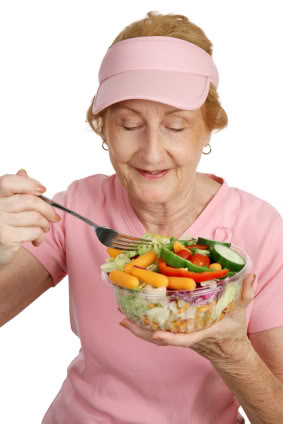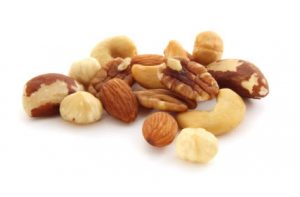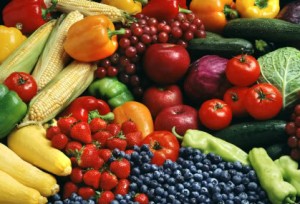To Your Health: October 2012
In this Issue:
- Nutrition and Lifestyle Factors to Help Decrease Breast Cancer Risk
- Your Health and Your Weight
- Beauty Foods
- Give Your Yogurt a Tweak and Go Greek
- Pink Power Smoothie Recipe
- News and Events
- Quote of the Month
A Note from Bonnie
October is National Breast Cancer Awareness Month and I would like to recognize those strong women who are breast cancer survivors, or who are currently fighting the disease. In this month’s newsletter, I address some nutrition factors that can decrease your risk of breast cancer, foods to make yourself and the women in your life more healthy and feel beautiful, and a recipe for a Pink Power Smoothie that includes one of my favorite healthy foods – Greek yogurt. It also celebrates the well-known pink color of the Breast Cancer Ribbon, and provides an anti-oxidant packed punch sure to knock down your risk of breast cancer! These days, almost everyone has a female close to their heart who has suffered in some way from the disease. Share this with them to show you care about their health and celebrate the strength they have that inspires us all to take care of ourselves and the ones we love!
Enjoy!
— Bonnie
Nutrition and Lifestyle Factors to Help Decrease Breast Cancer Risk
 Nutrition and lifestyle factors that may protect against breast cancer:
Nutrition and lifestyle factors that may protect against breast cancer:
1. Exercise. Participating in regular physical activity can help decrease estrogen levels, which can decrease risk for breast cancer.
How to incorporate: For those who don’t enjoy traditional forms of exercise such as walking, jogging, or participating in a structured fitness program, here are a few alternatives that will still have your heart pumping (and actually may be way more fun!)
- Sign up for a dance class. Zumba, ballroom dancing, hip hop, and ballet are all forms of exercise just not in a traditional format.
- Schedule 30 minutes a few times a week to play outside with children or grandchildren. Playing an old fashion game of kickball or soccer will certainly get the heart pumping and will be creating lasting memories.
- Wear a pedometer and just challenge yourself to 10,000 steps per day – that is like walking 3 miles! Once reaching the 10,000 steps per day goal, increase it to 12,000, then 15,000. The little extra steps will really make a difference and you won’t even need the gym.
2. Aim to eat a serving of beans or lentils at least twice a week.
How to incorporate: One night a week swap the traditional meat and potatoes dinner for beans and rice (preferably brown). Make this interesting by cooking white beans, lentil stew, split pea soup, and red beans and rice. No need to negate the health benefits of beans by adding high fat processed meats to the pot; instead try going vegetarian one night a week. For the second serving of beans try serving black beans, lima beans, or black eyed peas as a side dish to the family meal.
3. Increase fruit and vegetable intake. By eating a variety of fruits and vegetables instead of focusing on just one food, the total nutrition profile is increased. Research has found a positive correlation between a decrease in breast cancer risk and an increase in the following vitamins and minerals: vitamin D, C, A, and E, and calcium – just to name a few.
How to incorporate: The best way to incorporate this breast cancer fighting tip is to think about the plate as a rainbow. Start the day with an antioxidant and fiber packed blueberry shake, for lunch have a colorful tossed salad with broccoli, yellow squash, tomatoes, garbanzo beans, and topped with salmon and for dinner set a goal to have at least 3 different colors of foods on your plate (i.e. sweet potatoes, broccoli, black beans, red, yellow and green bell pepper stir fry).
4. Increase intake of monounsaturated fats and include more omega-3 fatty acids into the diet.
How to incorporate: Include more nuts, and seeds, baked seafood, canola oil, walnuts, flaxseeds into the daily food routine. Add fresh ground flaxseeds to a breakfast smoothie, opt to eat more seafood and less red meat, try snacking on nuts and seeds instead of traditional packaged foods.
Other cancer fighting tips include:
- Decrease high fat foods and meat intake
- Increase fiber intake
- Limit alcohol
- Include a daily garlic supplement, which may be beneficial
- Eat soy and soy products in moderation
- One study found that breastfeeding for more than two years may reduce breast cancer risk by half
For additional guidance and support on creating an anti-inflammation, breast cancer protective diet contact Bonnie at bonnie@brghealth.com or 516-486-4569.
Beauty Foods
Let’s face it, everyone wants to be beautiful. There is not a woman out there that is not striving in some way to be more beautiful. Either by trying to improve outward appearances or working on improving her inner-beauty, all are on a quest to be her most beautiful self.
There are actually foods that can help you be more beautiful from the inside –out. Many know there may be foods that can help make hair shinier, nails stronger, and skin look younger, but there are actually foods that can help improve inner-beauty! When the body is fueled properly, one can feel good about themself and it is much easier to be a nice, loving, patient and caring person – hence a more beautiful self. But if the body is being fed with empty calories and one struggles with low energy levels, mood swings, and irritability, being a more beautiful self becomes a lot more challenging.
Here are some nutrient dense foods that will help one reach a more beautiful self.
 1. H20 – yes, that is right – water. Water is absolutely essential to being more beautiful. The human body can survive six weeks withou t food, but only few days without water. Water is essential for almost every bodily function including digestion, absorption and transportation of vitamins and minerals, elimination, regulation of bodily temperatures, and many other metabolic processes. Staying hydrated helps keep skin moist and helps keep hunger levels in check. Being dehydrated can leave one feeling sluggish, irritable and even affect the state of one’s skin.
1. H20 – yes, that is right – water. Water is absolutely essential to being more beautiful. The human body can survive six weeks withou t food, but only few days without water. Water is essential for almost every bodily function including digestion, absorption and transportation of vitamins and minerals, elimination, regulation of bodily temperatures, and many other metabolic processes. Staying hydrated helps keep skin moist and helps keep hunger levels in check. Being dehydrated can leave one feeling sluggish, irritable and even affect the state of one’s skin.
 2. Raw Nuts: It is so hard to pin-point and focus on the health benefits of one specific nut. Instead it is much more helpful and healthy to encourage the consumption of a variety of nuts. In general nuts are rich in heart-healthy monounsaturated fats, vitamin E and potassium. Many also provide a great source of calcium, iron, magnesium, and zinc, folate, niacin and other B vitamins.
2. Raw Nuts: It is so hard to pin-point and focus on the health benefits of one specific nut. Instead it is much more helpful and healthy to encourage the consumption of a variety of nuts. In general nuts are rich in heart-healthy monounsaturated fats, vitamin E and potassium. Many also provide a great source of calcium, iron, magnesium, and zinc, folate, niacin and other B vitamins.
 3. Wild Salmon: High in omega-3 fatty acids and more specifically docosahexaenoic acid (DHA), salmon is the perfect beauty food. Not only will omega-3 fatty acids hel p keep the skin moistened and act as a natural wrinkle fighter, but it has also been found to help combat depression by boosting serotonin levels. Researchers at the National Institute of Public Health and the Environment in The Netherlands found that when comparing people who ate fish on a regular basis to people who consumed high amounts of vegetable oil, the fish eaters had a slower rate of cognitive decline as they aged.
3. Wild Salmon: High in omega-3 fatty acids and more specifically docosahexaenoic acid (DHA), salmon is the perfect beauty food. Not only will omega-3 fatty acids hel p keep the skin moistened and act as a natural wrinkle fighter, but it has also been found to help combat depression by boosting serotonin levels. Researchers at the National Institute of Public Health and the Environment in The Netherlands found that when comparing people who ate fish on a regular basis to people who consumed high amounts of vegetable oil, the fish eaters had a slower rate of cognitive decline as they aged.
 4. Red Bell Peppers, and other foods high in vitamin C. When it comes to skin’s health, vitamin C is essential in the formation of collagen, helping to keep skin plump and wrinkle free. Vitamin C is also essential for many things going on inside the body including: tissue growth and repair, adrenal gland function, maintaining healthy gums, the production of anti-stress hormones, and enhancing the immune system. This includes a variety of foods high in vitamin C such as papaya, oranges, broccoli, and berries.
4. Red Bell Peppers, and other foods high in vitamin C. When it comes to skin’s health, vitamin C is essential in the formation of collagen, helping to keep skin plump and wrinkle free. Vitamin C is also essential for many things going on inside the body including: tissue growth and repair, adrenal gland function, maintaining healthy gums, the production of anti-stress hormones, and enhancing the immune system. This includes a variety of foods high in vitamin C such as papaya, oranges, broccoli, and berries.
The bottom line is, eat food that will nourish rather than harm. Limit foods that zap the body of energy or create major energy crashes. When one is fueled correctly, it is so much easier to be that nice, loving, caring and patient person that we are all striving to be.
Give Your Yogurt a Tweak and Go Greek
 Women know that it’s important that they meet their daily calcium needs, and a great food that contributes to your 3 dairy foods a day is yogurt. But if you really want to reap the health benefits of yogurt, consider switching to Greek yogurt.
Women know that it’s important that they meet their daily calcium needs, and a great food that contributes to your 3 dairy foods a day is yogurt. But if you really want to reap the health benefits of yogurt, consider switching to Greek yogurt.
Greek yogurt is strained more extensively than regular yogurt, which decreases the amount of liquid, and gives rise to a thicker, creamier product. The straining process also removes more lactose, making it easier on the digestive system for people who have difficulty consuming dairy. The straining process also eliminates much of the sugar and is the reason plain Greek yogurt has less sugar than regular yogurt. Plain Greek yogurt has 5-8g of sugars compared to 13-17g you may find in regular varieties. It is also a great protein source for people cutting back on, or eliminating meat from their diets. A typical 6 ounce serving of Greek yogurt averages 15-20g of protein, which is about the same amount as 2-3 ounces of meat!
If you want to get the most benefit from Greek yogurt, stick with the plain varieties rather than the ones with fruit mixed in. That “fruit” can sometimes be fruit flavored syrups or other forms of hidden sugars, so it is best to add your own fresh fruit, nuts, or dark chocolate chips to Greek yogurt so that you are in control of the amount of added sugars. Also use it in smoothie recipes like the one we provide for you in this newsletter.
Recipe of the Month: Pink Power Smoothie
Bonnie R. Giller, MS, RD, CDN, CDE
BRG Dietetics & Nutrition, P.C.
8 large strawberries
1/2 sliced banana
3/4 cup raspberries
1/4 cup pomegranate seeds
6 ounces plain Greek yogurt
1 cup almond milk
1/4 cup almond butter
- Cut the tops off of the strawberries.
- Place the strawberries, banana, raspberries, pomegranate seeds, Greek yogurt, almond milk, and almond butter in a blender or food processor. Blend until smooth and creamy.
- Pour into a tall glass and garnish with a raspberry and strawberry on a toothpick.
Quote of the Month:
“Develop an attitude of gratitude, and give thanks for everything that happens to you, knowing that every step forward is a step toward achieving something bigger and better than your current situation.”
– Brian Tracy
New Program Now Being Offered at BRG Dietetics & Nutrition, P.C.
Stop dieting and start living! For more information on the iEat Mindfully™ Program visit www.ieatmindfully.com.
To receive Bonnie’s Free Report: 8 Ways to Repair the Damage Caused by Yo-Yo Dieting go to www.brghealth.com and click on 8 Free Tips. You will also get an advanced copy of the soon to be released 10 Fool Proof Ways to Beat the Stress without the Weight Gain.
FREE Complementary phone session with Bonnie! If you are interested in seeing if the iEat Mindfully™ program is right for you, simply email Bonnie with your request!
The Nutrition Key with BRG – Blog
If you haven’t yet signed up to follow the BRG Blog, Click here now so you don’t miss out on all the great success stores. You will receive an email with the link to each new post. Sign up now!
Your Health and Your Weight
Reproduced with permission of The Academy of Nutrition and Dietetics
Your health and your weight are connected. According to the Centers for Disease Control and Prevention, if your body mass index falls into the range of overweight or obese, you are at a higher risk for the following diseases and conditions:
- Coronary heart disease
- Stroke
- Type 2 diabetes
- Cancers (endometrial, breast and colon)
- Hypertension or high blood pressure
- Dyslipidemia (high blood cholesterol, high blood triglycerides)
- Liver and gallbladder disease
- Sleep apnea and respiratory problems
- Osteoarthritis (degeneration of cartilage and its underlying bone within a
joint) - Gynecological problems for women (abnormal menstrual periods and
- infertility).
What Does “At Risk” Mean?
Being “at risk” means you are more likely to have a specific disease or condition than someone who has a BMI in the normal weight range. It does not mean you will get the disease.
BMI is one screening tool. To assess your actual health risk, your health-care provider will look at many factors.
For example, if your doctor is concerned you might have a heart attack, he or she will want to know several things in addition to your BMI:
- Do you have a family history of heart disease?
- Do you smoke cigarettes?
- How much physical activity do you get every day?
- How much fat, saturated fat, fiber and sodium do you consume?
Your doctor also will likely run other tests, such as a blood pressure check and lab tests. Collecting all of this information is the only way to make an accurate assessment of your health risk and to diagnose a condition such as coronary artery disease.
Lifestyle Changes Make a Big Difference
If your doctor says your BMI is in the overweight range and you have high blood pressure, the doctor may prescribe medication and suggest you make changes in your lifestyle. You may be told to lose weight, change your diet and get more exercise. Here’s some really good news: Those lifestyle changes – eating smarter and moving more – will help lower your blood pressure no matter what happens with your weight. Since losing and then keeping weight off can be a challenge, it is reassuring to know lifestyle changes by themselves can reduce your risk; they can help you feel better too.


Trackbacks & Pingbacks
[…] more helpful tips, check out my October 2012 To Your Health Newsletter in honor of National Breast Cancer Awareness […]
Leave a Reply
Want to join the discussion?Feel free to contribute!